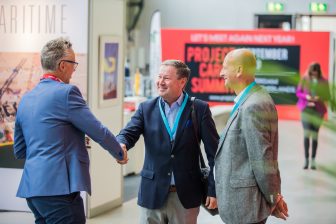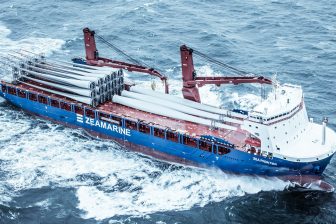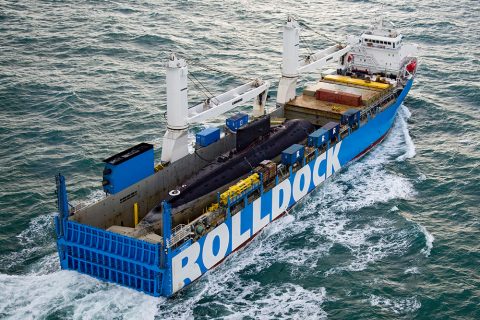
Rolldock: “We do not compete with BigLift or Jumbo Shipping”
With eight ships owned and in management, it is a rather small shipping company, yet one of the most versatile in shipping project cargo: RollDock. Its ships can partially submerse to float-on and float-off (flo-flo), to roll-on and roll-off (ro-ro) and can lift heavy cargo. Moreover, where most shipping companies offer just to transport cargo from quay to quay, RollDock offers a “Factory to Foundation” solution from the doorstep of the factory where the cargo is manufactured, to the place where it has to be installed, in cooperation with sister company Roll-Lift.
RollDock was established in 2006 when one of the two main-investors, Frans van Seumeren, withdrew from Mammoet and could start his own heavy transport solutions company. The philosophy of Roll Group is based on developing innovative engineered solutions for every heavy lifting, transport and installation challenge on land and at sea.
RollDock owns five dock-type vessels and two ice-classed Module Carriers, which are specially designed to deliver the heavy modules and equipment. In addition, RollDock manages the Combi Dock I, a German-owned semi-submersible ro-ro heavy lift vessel. On the land side, Roll-Lift operates a large number of modern heavy lift cranes and a vast array of self-propelled modular trailers (SPMTs) and conventional trailers. Roll Group is active in a wide range of markets such as the oil and gas, dredging, naval, petrochemical, renewables, energy, power, civil construction, river cruises and superyachts markets.
As a specialist in transporting heavy and voluminous cargoes, shipping company RollDock officially started on 1 December 2006. Rik Hofsté, currently the Executive Director, was one of the founding fathers and former Mammoet owner Van Seumeren one of the main investors. The company now houses a modern office in the municipality of Capelle aan den IJssel, bordering the city of Rotterdam. Captain Hofsté brought in his nautical experience that he built up in a career that started with the renowned tug and heavy transport shipping company Smit Internationale and thereafter with Zadeko Shipping BV, a shipping company that owned several heavy-lift roro/lo-lo (lift-on/lift-off) vessels and a semi-submersible dock-ship. He has sailed as a master on heavy transport vessels and has experience with submersible and ro-ro lift ships like Condock-type ships.
Combining Three Transport Options
Zadeko Shipping can be considered as the predecessor-company of RollDock. The idea of forming RollDock was to specialise fully on transporting heavy cargoes with ships that could submerse to float cargo in and out, roll cargo on and off in dock or on deck and able to lift with cranes, thus combining three transport options. In-house, Hofsté and colleagues developed a new ship type that fulfilled all these demands.
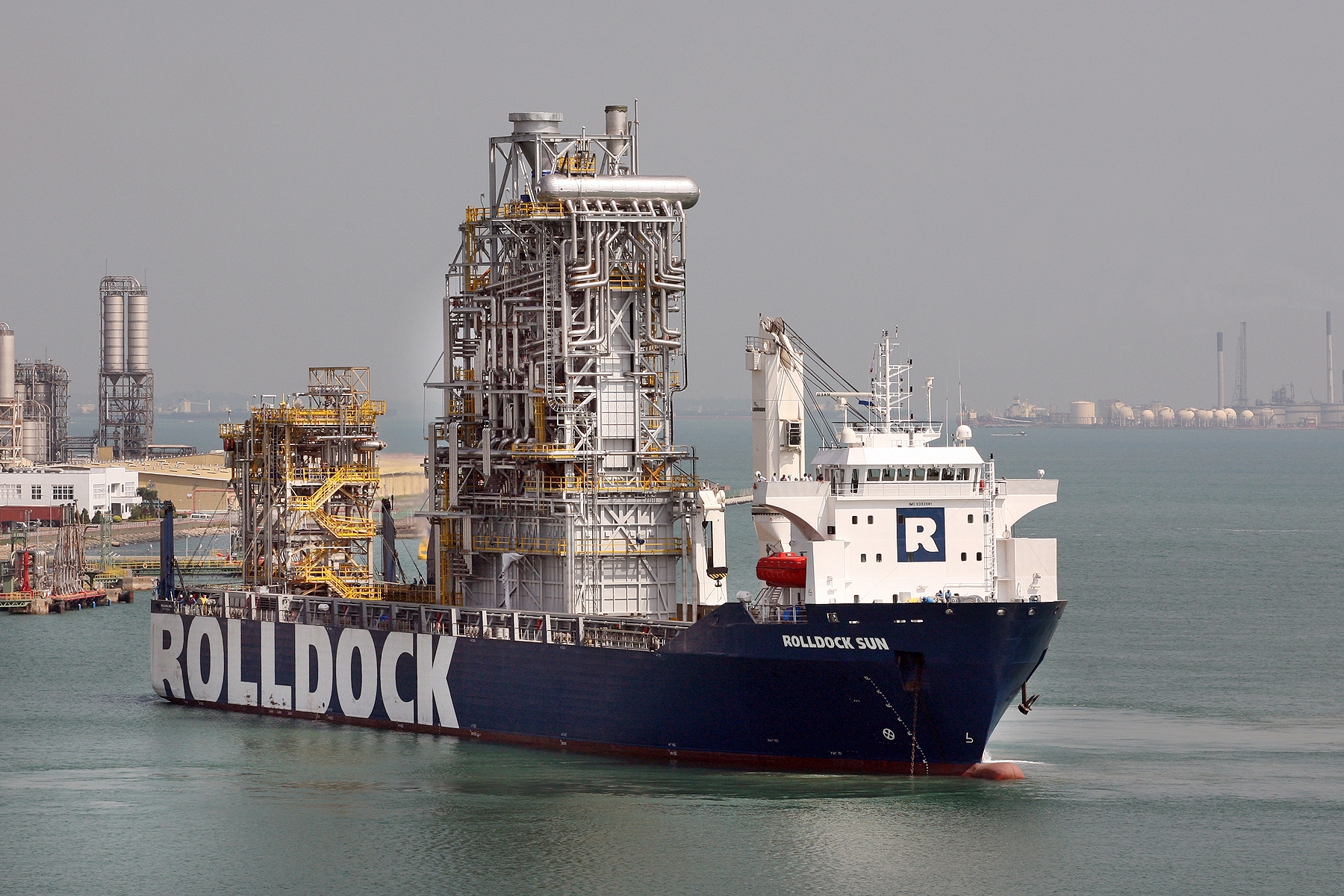
With a heavy investment of Van Seumeren and another participant that prefers to stay anonymous, RollDock already placed an order for four ships with an option of another four at the shipyard of Indian industrial conglomerate Larsen & Toubro in Mumbai in 2006. Yet, it took an enormous amount of time to have the ships constructed at the yard in India. That long that RollDock was forced to cancel the order for two of the first four and leaving the option unused. The company then ordered two other ships at the shipyard of Flensburger Shiffsbau Gesellschaft (FSG) in Flensburg, Germany. The first ship from India, the RollDock Sun was eventually delivered in 2010, followed by the RollDock Sea in 2011. In the end, a third was bought from this yard after all: the RollDock Sky in 2016.
Until delivery of the ordered newbuilds, RollDock, however, had been functioning without ships for 2.5 years after the sale of the last Zadeko-ships in 2007/8. During those years without ships, RollDock succeeded in obtaining some prestigious projects for the new ships. The first assignment for the first ship, the RollDock Sun, was from oil major Exxon for the transport of a boiler plant with installations of up to 55 metres high and weighing 2500 metric tonnes for building a completely new refinery in Singapore. ‘The units were specifically engineered to the dimensions of our ship,’ tells Hofsté. The RollDock Sun went up and down from the manufacturing site in Thailand to the Jurong-site where the new refinery was built seven times.
More Protection
Hofsté says he always believed in the existence of a market for the dock-ships. ‘Compared to a wide deck carrier, a dock-ship provides more protection. Therefore, a dock-ship is especially interesting for military and offshore purposes. Of all the cargo we have done, 85 per cent has been flo-flo and ro-ro, the rest was lifted. This also
means we do not compete with companies such as BigLift or Jumbo Shipping, which are much more lifting market-oriented. They can lift up to 2000 tonnes, where we are limited to 700 tonnes,” explains Hofsté.
The construction of ever-bigger modules has taken an enormous flight resulting in the need for ever wider carriers.
According to Hofsté, the experience of RollDock has shown that next to floating in and out, his company is particularly interesting for cargoes that can roll. “Unlike others, we think rolling is safer than lifting. Most of the cargo that is offered to shipping companies like us is already delivered on trailers. So, for us, it is just as easy to roll the cargo instead of lifting it. Furthermore, the cargo is becoming bigger and bigger. The construction of ever-bigger modules has taken an enormous flight resulting in the need for ever wider carriers. We are now going into the direction of modules of 7000/8000 tonnes measuring forty by 125 metres. We have already transported such cargoes to the Yamal site in Northern-Russia with our Module Carriers,” says Hofsté.
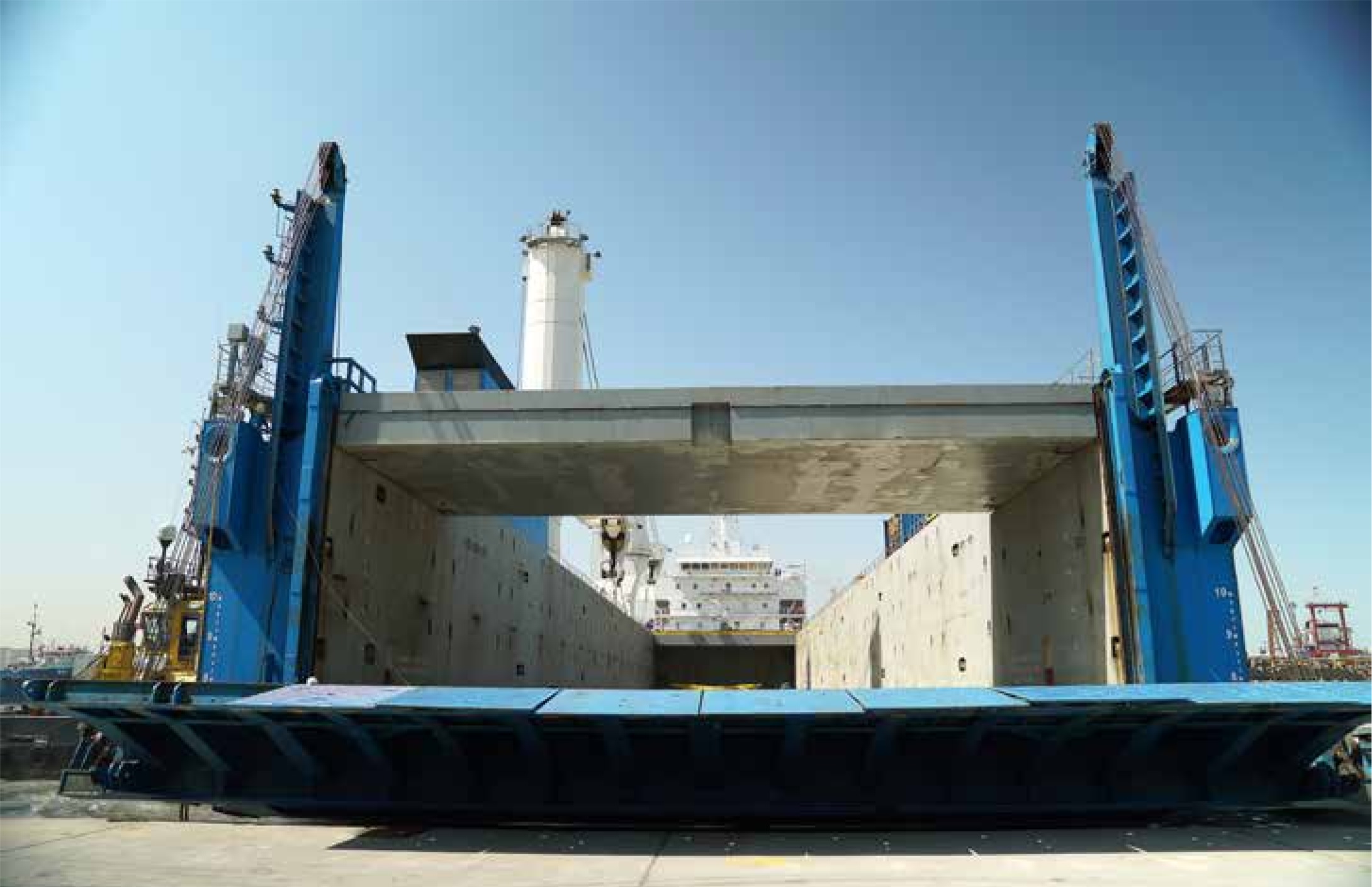
He is proud of the design of the RollDock vessels. From his experience with the Condock-ships, he was convinced that there was a future for this type of heavy transport ships. Hofsté: “We saw that the cargoes, especially those for offshore and ro-ro-projects, became bigger and bigger. So, we looked at what type of ships we could have built. This resulted in ships with a hold of 117 by 19 metres that could submerse till a draft of 6.75 metres to be able to float cargo in and out. Therefore, the ship itself had to submerse till 12.5 meters. This is enough to handle most of all cargoes. The submersing operations we always perform in port or a well-protected area.”
In India, all engineering problems are solved by using more steel. So these three ships are tremendously strong.
Transporting Dredgers
For ro-ro cargoes, the S-class RollDock-ships can handle up to 2750 tonnes and the ST-class up to 3250 tonnes per unit to pass over the ramp. “That was what the market demanded. For the ST-class ships built in Flensburg, we chose for a slightly bigger hold of 120 by 19.40 metres. When we designed these ships, we saw that several dredgers and cutters had a width of 19 metres. Transporting dredgers around the world is an important market for us,” Hofsté explains.
For both types, the concept-design was done in-house by the RollDock engineers. The detailed design was done by a design bureau or the shipyard and the model was tested at the Maritime Research Institute Netherlands (Marin) in Wageningen. For sailing with a so-called open-top notation (without the hatches) and with different
load scenarios, the ship had to fulfil special trials at Marin in rough sea conditions. The strength calculations were performed by PT Structural Design & Analyses in Bolnes. “For loading over the ramp, we had planned for 2300 tonnes. The calculations learned that we had more strength than expected and that we could go till 2750 tonnes. Out of precaution, in India, all engineering problems are solved by using more steel. So these three ships, the Sun, Sea and Sky are tremendously strong ships,” says Hofsté.
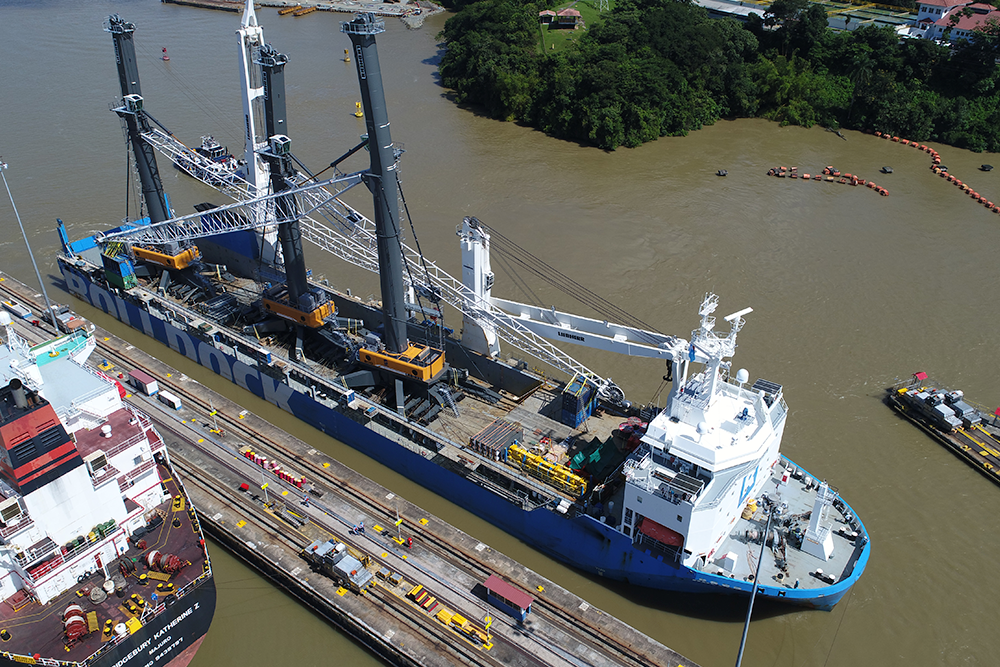
‘Rolls-Royces’
All of the experience with the S-class ships has been put into the design of the slightly bigger ST-class ships; the RollDock Star and RollDock Storm that have been built at the shipyard of FSG in Germany. Hofsté: “These are the Rolls-Royces among this type of ship. As an owner, I think you cannot wish for finer ships.” Building in India was relatively cheap, but after all the delays, RollDock needed more certainty about the delivery of the ordered ships. “Shipbuilding prices were moderate at that time, so we could have the ships built in Germany. The shipyard at first had to get used to our approach. It is always a bit strange for a yard when a shipowning company knows exactly how to design a ship and has insight into the designing process. Yet, we succeeded in a tremendously good cooperation with the German yard,” Hofsté states.
As an owner, I think you cannot wish for finer ships.
This insight stems from RollDock’s transport projects. “For our work, we have to calculate an enormous lot. We have our own naval architects that do the stability and structural calculations for the cargoes we have to transport. Therefore, we were able to make our own in-house concept of the vessel we needed. The engineering department is the largest of the company as it provides calculations for both RollDock and Roll-Lift. Especially for the big oil majors like Shell or Exxon, you have to present a lot of calculations to assure that the cargo reaches its destination exactly as it has been engineered and built for. For complex projects, such as refineries and factories, the demands are high. For these bigger projects, you need an experienced team of engineers.”
Life-long career
In total, Roll Group has about eighty people at the office. For the crewing of the eight ships RollDock owns (seven) and manages (one), the company employs ninety Dutch officers and 65 ratings from the Philippines. The crew of a ship consists of seventeen officers and ratings plus one trainee. Most of the Dutch officers stay with RollDock for a long time. “Most of them have built their career with us. From the seafarers that started with us in 2010, several are
now a captain on our ships,’ says Hofsté. ‘We are still an old-fashioned shipping company that handles everything itself. The technical operation of loading, crewing, operations of the fleet, commerce, maintenance and so on; we do everything ourselves.” Fuel prices are of course very important for the operations.
S-class ships can reach a speed of eighteen knots, the ST-class sixteen knots, but these top speeds will only be applied when necessary, for example when sailing through piracy-infested areas. Normal operating speed is 14.5 to fifteen knots. All the ships are equipped with onboard software to monitor and control speed and fuel consumption.
We decided to buy this third vessel as well. Otherwise, it would have fallen into the hands of our competitors.
Fruitful Years
RollDock experienced fruitful years after the delivery of the first vessel, the RollDock Sun in 2010. A year later, the RollDock Sea came into service, followed by the RollDock Star in 2013 and the RollDock Storm in 2014. “In 2016, we were approached by Larsen & Toubro whether or not we would still be interested in buying the third ship of the S-class. After we cancelled our initial order, the shipyard had continued the building of the third ship for its own account. As we knew what the first two ships were capable of, we decided to buy this third vessel as well. Otherwise, it would have fallen into the hands of our competitors,” Hofsté tells.
Eventually RollDock also had to deal with economic headwinds, much later than the global economy. While 2015 was still satisfactory, the change in the market was noticeable in the three subsequent years. “The main reason for this was that the oil- and gas-industry stopped investing in 2015. This had an enormous impact on our markets with negative consequences for other industries such as the dredging business. Fewer oil- and gas-projects often also mean fewer orders for the dredging industry linked to the development of new ports,” says Hofsté. For the employment of its ships, RollDock then also looked to other markets including the transport of super yachts and river cruise vessels. A market that has always been a steady client, are the navies around the world for transport of navy vessels, for example submarines, minesweepers or navy vessels that have to be repaired.
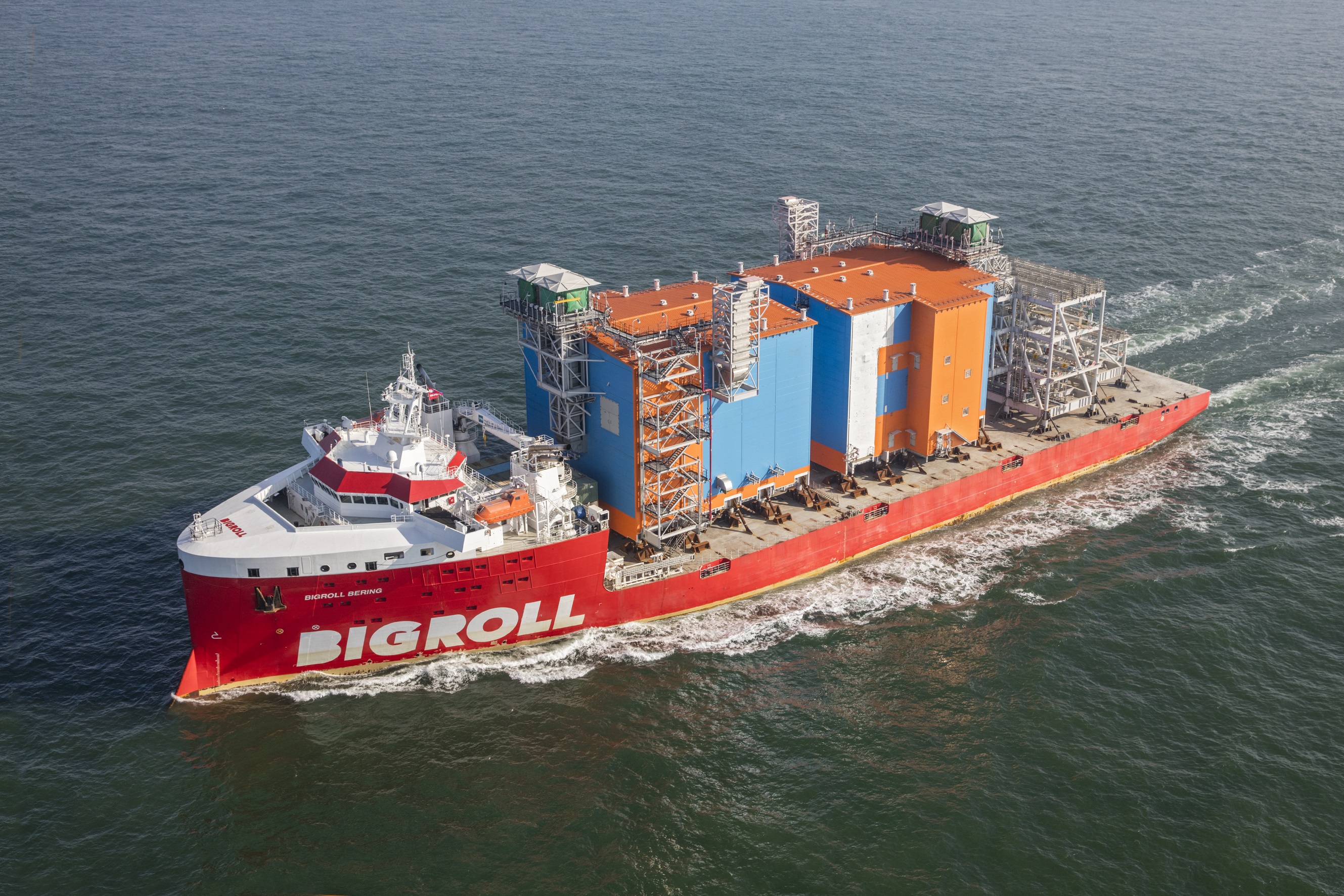
Transporting Damaged Ships
A rather new, but promising market is that of salving damaged ships from remote places as the insurers are more and more convinced by RollDock that this is a reliable solution. Often those ships cannot sail themselves as they are leaking heavily. The transport behind a tug is often too risky and may result in the vessel sinking en route to
a shipyard. Docking a damaged vessel into a RollDock-ship then offers a safe and stable solution to transport it to a yard for repair or demolition.
In such a way, RollDock transported a damaged expeditionary cruise vessel from Antarctica to Denmark and lately a yacht that had gone on the rocks on the coast of Greenland. This damaged yacht was docked in on a RollDock ship and transported for repair to the United Kingdom. The same happened with a ship that ended on the rocks of Iceland that could not be towed anymore after salvors had recovered it. On another occasion, RollDock docked in a navy frigate that had been ripped open on a reef thirty miles off the coast of Brazil. “The strength of our ships is that we can submerge them up to 12.75 metres. That is enough for most ports, which often have a draft of
13.50 to fourteen metres. For a navy frigate or submarine, we need this maximum draft to get the navy vessel inside our cargo hold,” says Hofsté.
In the oil and gas market, we foresee a turn-around with large-scaled projects that will be realised in the coming years.
Besides the dock for flo-flo operations, the RollDock ships also have a ro-ro deck. By installing this deck to the right height, the company can cope with practically every quay in every port or along riversides where factories are located. Hofsté: “With this capability, our ships can compete with a lot of other ship types. The draft we need is relatively low, so we can load or discharge on a lot of places that are too shallow for our competitors. Due to these characteristics, we were awarded a project from Total Oil for the transport of an ethylene cracker that is being built in the Emirates and has to be transported to Port Arthur in Texas. Both loading and discharge port had draught restrictions and our vessels could handle both without the use of intermediate barges. As Roll-Lift is taking care of a part of the operation on land, this is a perfect example of the Factory to Foundation philosophy that Roll Group offers.”
Consolidate and Further Growth
After the economically lean years, it is now time for RollDock to consolidate: “We have a first-class company with a reliable and safe reputation, and quality is our priority. In this business, your reputation is very important. Thanks to our reputation we also see a lot of clients returning for their next projects. The market just has to recover, but we look to the future with confidence. In the oil and gas market, we foresee a turn-around with large-scaled projects that will be realised in the coming years. That will offer us all the opportunities to grow further.”
This special long-read is one of many interesting stories from the Project Cargo Special of our sister publication SWZ Maritime. DOWNLOAD your own digital copy of the magazine HERE.
Rolldock will be one of the key speakers at the Project Cargo Summit, which Promedia is organising at the 11th and 12th of September. At the Project Cargo Summit, Rolldock will plead for modernisation of the lashing regulations which currently cost ship operators large and unnecessary sums of money. For more information about this two-day international event, please visit the event page at www.projectcargosummit.com.

